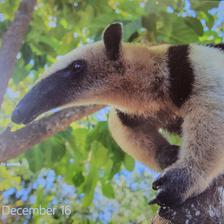
Species: Anteater
Location: United States
Date: 2021-12-16
Time: 20:18:25.054000
Source: Animal Identifier
Location: United States
Date: 2021-12-16
Time: 20:18:25.054000
Source: Animal Identifier
Of the four anteater species, the giant anteater is the largest, usually measuring five to eight feet long from nose to tail, weighing up to 140 pounds. It has a long nose and a narrow head with small eyes and round ears. Giant anteaters have coarse grey or brown hair with a white-and-black stripe running the length of its body. The bushy tail is two to three feet long. Giant anteaters are animals with long front claws, which they curl under to walk. They use their powerful legs and claws to ward off larger animals and can become aggressive when cornered, rearing up on their hind legs, using their tails for balance. They are generally asocial, avoiding other animals, including other anteaters, only coming together to mate. These animals have poor vision, so they use their keen sense of smell, which is 40 times more powerful than humans, to find food. Giant anteaters have tongues that can reach two feet, beginning at their breastbones. Backward-facing spiny projections cover their tongues, which, combined with their sticky saliva, helps collect bugs.
We have observed Anteater 21 times world wild from 2021-08-18 till this date with the last observation being in 2022-09-29 in Peru.
Our data suggest that Anteater are highly active in January, December and September world wild but differences observed on country level, while the lowest activity observed on November and February.
We noticed also the top 3 countries to observe Anteater in are: Colombia, Malaysia and Argentina respectively.
We have observed Anteater 21 times world wild from 2021-08-18 till this date with the last observation being in 2022-09-29 in Peru.
Our data suggest that Anteater are highly active in January, December and September world wild but differences observed on country level, while the lowest activity observed on November and February.
We noticed also the top 3 countries to observe Anteater in are: Colombia, Malaysia and Argentina respectively.